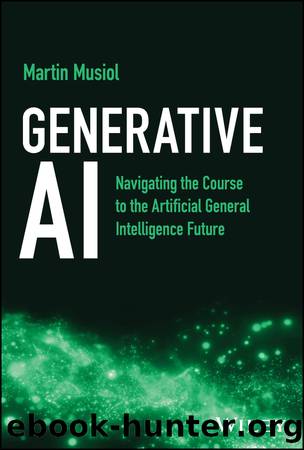Generative AI by Martin Musiol

Author:Martin Musiol [Musiol, Martin]
Language: eng
Format: epub
ISBN: 9781394205943
Publisher: Wiley
Published: 2024-01-04T00:00:00+00:00
FIGURE 3.21 How to come up with your generative AI idea in this dynamic AI market.
The first step in this journey is to immerse yourself in trusted sources of information. I strongly recommend research papers available on databases like arxiv.org and publisher-driven platforms such as Wiley. Choose one or two that resonate with you after conducting preliminary research.
While your focus is on AI, it's beneficial to cast a wider net. Consider filtering for papers in related domains such as physics, chemistry, mathematics, and psychology. This broad perspective can provide insights into market trends and hot topics in these fields.
For the next three to six weeks, observe these research databases and their respective topics. Useful tools for this task are the ChatGPT plug-ins. Each day, select the top five papers you wish to understand and paste their links into ChatGPT. Ask the respective plug-ins to summarize these papers in bullet points, including headers. This method allows you to grasp the essence of each paper in about seven minutes.
For instance, just today's research is rich with ideas, potentially meeting the criteria. âDUCHO: A Unified Framework for the Extraction of Multimodal Features in Recommendationâ2 proposes an approach to improve recommendations by including effectively multiple modes.
Another paper, âSynthetic Demographic Data Generation for Card Fraud Detection Using GANs,â3 might not pass the threshold. While it focuses on demographic data, which seems quite limited, there could be potential to use this idea in other areas of data generation. This is something that would need further investigation.
Lastly, I found a paper titled âSpiking Denoising Diffusion Probabilistic Modelsâ4 particularly intriguing. This paper combines spiking neural networks with diffusion models. The key questions here are: What benefits does this combination offer? What are the drawbacks? And most importantly, what new functionalities does it introduce that could potentially transform other areas? Often, even the authors themselves may not fully grasp the implications of their work.
After this initial review, choose one paper for a deeper dive. Read it thoroughly, examine the visual results, and absorb its content. After some training, this process should take no more than 30 minutes per day.
It's crucial to research papers over an extended period to avoid the trap of latching onto the first good idea that comes along. Comparing ideas against each other is an important part of the process. However, it's equally important to set a time frame for when you want to start your project.
Once you've gathered a wealth of ideas, it's time to select a great one. Not the perfect one, as perfection is elusive, but a great one. Shortlist the top five to seven ideas and compare them qualitatively based on the following criteria: technical feasibility, potential impact for end users, innovation and uniqueness, scalability and adaptability, ethical and legal considerations, resource requirements, and market potential.
Once you've selected an idea, create a quick proof of concept (PoC). Utilize existing GitHub repos or other code sources like paperswithcode.com or from the research scientists themselves. If you're not a coder, consider hiring one from platforms like Fiverr, but be aware of potential issues like confidentiality and skill gaps.
Download
This site does not store any files on its server. We only index and link to content provided by other sites. Please contact the content providers to delete copyright contents if any and email us, we'll remove relevant links or contents immediately.
Ansible for Real-Life Automation - A complete Ansible handbook filled with practical IT automation use cases (2022) by Packt(613)
Learn Wireshark - A definitive guide to expertly analyzing protocols and troubleshooting networks using Wireshark - 2nd Edition (2022) by Packt(567)
Data Engineering with Scala and Spark by Eric Tome Rupam Bhattacharjee David Radford(336)
Kubernetes Secrets Handbook by Emmanouil Gkatziouras | Rom Adams | Chen Xi(194)
Power BI for Jobseekers by Alan Murray(148)
Machine Learning for Imbalanced Data by Kumar Abhishek Dr. Mounir Abdelaziz(146)
Data Labeling in Machine Learning with Python by Vijaya Kumar Suda(136)
Learn PyCharm (Python Technologies) by HASANRAZA ANSARI(133)
The AWK Programming Language by Aho Alfred V. Kernighan Brian W. Weinberger Peter J. & Brian W. Kernighan & Peter J. Weinberger(133)
Hands-On Scikit-Learn for Machine Learning Applications Data Science Fundamentals with Python by David Paper (Apress;2019;9781484253724;eng)(133)
SWIFT AND C++ PROGRAMMING MADE SIMPLE: A BEGINNERâS GUIDE TO PROGRAMMING - 2 BOOKS IN 1 by STOKES MARK(125)
Programming for Problem-Solving with C by Kamaldeep;(124)
Asynchronous Programming in Rust by Carl Fredrik Samson;(124)
The Influence of a Self-Avatar on Space and Body Perception in Immersive Virtual Reality by Ivelina Piryankova(119)
Quantum Machine Learning by Claudio Conti(111)
Practical Machine Learning on Databricks by Debu Sinha(110)
Addison-Wesley Learn Python the Hard Way, A Very Simple Introduction to the Terrifyingly Beautiful World of Computers and Code 3rd (2014) by Unknown(108)
Cyber Forensics up and Running by Vashishth Tarun;(103)
Graph Data Science with Python and Neo4j: Hands-on Projects on Python and Neo4j Integration for Data Visualization and Analysis Using Graph Data Science for Building Enterprise Strategies by Timothy Eastridge(101)
